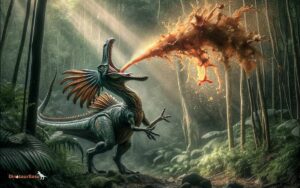How Do Dinosaurs Play With Their Friends
Navigating the prehistoric playgrounds, dinosaurs' social behaviors remain as enigmatic as a shadow in the fog. Scientists speculate on how these ancient giants interacted with their kin, suggesting rituals and games that might mirror the complex social structures of animals today.
From the gentle giants to the fierce predators, each species likely had its own unique way of engaging with friends. But what evidence supports these theories, and how do modern animal behaviors provide clues to these ancient mysteries?
The answers lie buried, waiting to be unearthed, promising to shed light on aspects of dinosaur life that have long remained in the dark.
Key Takeaways
- Dinosaurs engaged in non-contact play like tag to foster social engagement.
- Mutual grooming among dinosaurs strengthened social bonds within groups.
- Playful wrestling and mock combat indicated the development of survival skills.
- Chase and capture games were used to hone speed and agility.
Unearthing Dinosaur Playgrounds
Scientists have uncovered evidence suggesting that certain areas may have served as communal spaces where dinosaurs engaged in social behaviors, including play. Through detailed analysis of the fossil record, they've identified specific sites that exhibit characteristics indicative of repeated, congregative activities.
These locations, often rich in footprints and other trace fossils, point towards dinosaurs returning frequently, hinting at complex social structures and possibly even communal learning environments. The implications of these findings are profound, suggesting that dinosaurs may have possessed a level of social intelligence previously unattributed to them.
Social Giants of the Mesozoic
Building on the discovery of communal spaces that suggest complex social interactions, the focus shifts to exploring the intricate social hierarchies and behaviors of the Mesozoic era's most formidable inhabitants. Researchers have unearthed evidence indicating that these prehistoric giants, such as the towering sauropods and the formidable theropods, engaged in sophisticated social practices.
Fossilized footprints reveal patterns of movement that suggest communal hunting, migration, and potentially even caregiving behaviors among certain species. These findings challenge the long-held view of dinosaurs as solitary creatures, instead unveiling a world where social bonds and group dynamics played a crucial role in survival.
The analysis of bone beds and nesting sites further supports the theory that dinosaurs organized themselves into complex societies, highlighting a previously underappreciated aspect of their evolutionary success.
The Rituals of Raptors
Raptors utilized complex communication methods, signaling to one another through vocalizations and body language to coordinate actions and establish social hierarchies.
Their hunting techniques, often executed in groups, showcased strategic planning and role differentiation among pack members, indicating a high level of social cooperation.
These behaviors not only facilitated efficient predation but also reinforced social bonds within raptor communities, highlighting their sophisticated social dynamics.
Raptor Communication Methods
Communication rituals among raptors involve a complex array of vocalizations, body language, and feather displays, reflecting their social dynamics and hierarchy. These creatures, known for their keen senses and intelligence, navigate their social world through nuanced interactions.
Vocalizations range from soft calls within close-knit groups to loud, piercing cries signaling territory or dominance. Body language plays a critical role, with postures and movements conveying intentions, mood, and social standing. Feather displays, often overlooked, serve as visual signals, accentuating gestures or vocal calls, and can indicate everything from aggression to courtship intentions.
This intricate communication system underpins the social fabric of raptor communities, allowing them to cooperate, resolve conflicts, and maintain order without the constraints of verbal language, embodying a form of freedom in their social interactions.
Hunting Techniques Together
In their quest for prey, raptors employ a sophisticated array of cooperative hunting tactics, showcasing their intelligence and adaptability in the wild. These techniques are not only about strength but also about the strategic positioning and timing, allowing them to tackle even the most challenging hunts with precision and teamwork.
| Technique | Description |
|---|---|
| Flanking | Raptors spread out, encircling their prey before closing in. |
| Distraction | One or more members draw the attention of the prey, while others attack from behind. |
| Ambush | Utilizing the element of surprise, raptors hide and wait for the perfect moment to strike. |
| Relay Hunting | They take turns chasing the prey to tire it out, ensuring a successful hunt with minimal energy expenditure. |
This cooperative behavior emphasizes their social structure and the importance of working together for survival.
Social Bonding Behaviors
Beyond their cooperative hunting strategies, raptors also exhibit complex social bonding behaviors that underscore their sophisticated social dynamics. These behaviors, ranging from vocal communications to physical displays, serve as crucial mechanisms for establishing and maintaining hierarchies within groups.
Vocalizations, often unique to specific individuals or clans, facilitate long-distance communication, reinforcing social bonds even when members are apart. Physical interactions, such as mutual grooming or synchronized movements during flight, enhance group cohesion and trust. These rituals aren't mere displays of dominance but rather intricate dances of cooperation and mutual respect.
Fossilized Fun: Evidence of Play
The examination of fossilized remains has revealed intriguing evidence of playful behaviors among dinosaurs, indicating complex social interactions within these ancient communities.
Patterns discerned in bone arrangements and trace fossils suggest that dinosaurs engaged in activities resembling games, providing a glimpse into their social dynamics and cognitive abilities.
These findings underscore the importance of play in the development and maintenance of social bonds in prehistoric ecosystems.
Playful Behaviors in Fossils
Remarkably, a growing body of evidence from fossil records suggests that dinosaurs engaged in playful behaviors, challenging long-held assumptions about their social interactions. Researchers have unearthed fossils with patterns indicating group activities that resemble play.
For instance, trace fossils, such as tracks or nests, show evidence of repeated, non-functional movements that scientists interpret as playful. These findings point to a complex social structure where play served as a mechanism for learning and bonding.
Additionally, some theropod tracks suggest chase-like behaviors, possibly indicating play among juveniles. This evidence pushes the boundary of our understanding, suggesting dinosaurs weren't just survival-driven beasts but had a capacity for joy and social learning.
It's a significant shift that adds depth to our perception of these ancient creatures, highlighting their behavioral complexity.
Social Interactions: Ancient Evidence
Several fossils reveal intricate patterns of behavior, suggesting dinosaurs engaged in complex social interactions, including play, which was previously unseen in the paleontological record. This evidence points to a more nuanced understanding of dinosaur social life, illustrating not just survival instincts but also the capacity for enjoyment and possibly even emotional bonds among these ancient creatures.
- Trackways showing synchronized movements indicate cooperative behavior or social learning.
- Bonebeds with mixed-age groupings suggest communal living spaces or social gatherings.
- Healed injuries on skeletons imply care within the group, hinting at social bonds.
- Nest arrangements with strategic positions for protection and warmth indicate a level of planning and communal effort.
These findings paint a vivid picture of dinosaurs as socially complex beings, challenging the solitary predator myth and opening new discussions on their behavioral ecology.
Dinosaur Games: Fossil Clues
Building on the understanding of complex social structures, recent studies have uncovered fossilized evidence suggesting that dinosaurs engaged in playful activities with their peers. Trace fossils, such as parallel tracks and unusual patterns, indicate instances where dinosaurs might've chased each other in a manner similar to play. Moreover, specific bone formations and wear patterns hint at repetitive, non-survival related movements, possibly reflecting playful wrestling or mock combat.
This data challenges the traditional view of dinosaurs as solely survival-driven creatures, opening up discussions about their emotional and social complexity. By analyzing these fossil clues, scientists can deduce not just the physical capabilities but also the social behaviors of these ancient beings, offering a window into their daily lives far beyond the hunt for food or mate.
Gentle Giants' Games
Despite their massive size, some dinosaurs engaged in surprisingly delicate play with their peers, demonstrating a level of social interaction that challenges our understanding of prehistoric behavior.
- Mutual Grooming: Evidence suggests that certain large herbivores participated in mutual grooming, a behavior that strengthens social bonds and promotes group cohesion.
- Vocal Communication: Analysis of fossilized skull structures indicates that some species used complex vocalizations to engage with one another, likely including calls that were playful in nature.
- Non-contact Play: Tracks and other fossil evidence point to the existence of non-contact games, such as tag, where dinosaurs chased each other without physical contact.
- Environmental Interaction: Dinosaurs also interacted with their environment in playful ways, manipulating objects or playfully splashing in water.
These activities suggest a nuanced social structure among these ancient giants, where freedom in social engagement was paramount.
Predatory Playtime Behaviors
Predatory playtime behaviors in dinosaurs often involve the mimicry of hunting tactics, providing insights into their predatory strategies and social dynamics. These activities likely served as crucial mechanisms for young dinosaurs to hone their hunting skills and understand their role within the social hierarchy.
Analyzing such games reveals complex interactions that underline the importance of play in the development of social and survival skills among these ancient creatures.
Hunting Tactics Mimicry
Dinosaurs often engaged in playtime activities that closely mirrored their hunting tactics, offering insights into their predatory behaviors and social interactions. This mimicry not only facilitated the development of essential survival skills but also fostered a deeper understanding of their complex social structures. The emulation of hunting strategies during playtime underscores the evolutionary significance of such behaviors.
- Chase and capture games simulated the pursuit of prey, honing their speed and agility.
- Mock battles allowed them to practice combat maneuvers and establish dominance without serious injury.
- Stealth tactics were rehearsed through hide-and-seek play, enhancing their ability to ambush.
- Cooperative hunting strategies were refined as they learned to work together, strengthening social bonds.
These activities provided dinosaurs with the freedom to explore and master the skills necessary for survival in their dynamic ecosystems.
Social Hierarchy Games
In the intricate social structures of dinosaur communities, games that established social hierarchy served as a critical mechanism for determining ranks and roles within groups. These activities weren't merely for amusement; rather, they were pivotal in maintaining order and ensuring efficient group dynamics.
Predatory playtime behaviors, for instance, mimicked hunting strategies, allowing individuals to showcase their strength, agility, and strategic thinking. Dinosaurs engaged in mock battles, chases, and displays of prowess that mirrored real-life survival scenarios. Such games facilitated the identification of leaders, skilled hunters, and adept strategists within the community.
They were instrumental in teaching younger members vital survival skills, ensuring the group's longevity. Importantly, these hierarchical games fostered a sense of unity and cooperation, essential for the survival and prosperity of these ancient creatures.
The Herd Mentality
Understanding the herd mentality among certain dinosaur species reveals complex social structures and behaviors aimed at survival and communal living. This mentality, deeply ingrained in their behavior, showcases an evolutionary strategy for thriving within their ecosystems. The dynamics within these groups highlight:
- Collective Vigilance: Members share the responsibility of watching for predators, enhancing the safety of the entire herd.
- Resource Sharing: They exploit feeding grounds collectively, ensuring equitable access to food.
- Social Learning: Younger or less experienced members learn survival tactics from observing and mimicking older, more experienced ones.
- Emotional Bonds: Strong, interpersonal relationships are formed, fostering a sense of belonging and mutual care.
These elements underscore the sophisticated social fabric that dinosaurs developed, emphasizing the importance of community for their survival and prosperity.
Communication Through Play
Building on their complex social structures, certain dinosaur species also exhibited sophisticated forms of communication through play, highlighting an integral aspect of their communal interactions and learning processes. These activities weren't merely for entertainment; they were critical in the development of social hierarchies and survival skills. Through play, juveniles learned to interpret signals, understand social cues, and establish connections, fostering a cohesive group dynamic essential for their survival.
| Species | Play Activity | Communication Skill Developed |
|---|---|---|
| Velociraptor | Mock combat | Strategy and hierarchy recognition |
| Triceratops | Horn butting | Strength assessment and bonding |
| Parasaurolophus | Vocal mimicry | Social bonding and signal interpretation |
This table underscores the variety and complexity of playful interactions, each tailored to the specific needs of the species, advancing their evolutionary success through enhanced communication.
Playful Parenting Dinosaurs
Dinosaur parenting practices, notably through playful interactions, were pivotal in nurturing offspring survival skills and social intelligence. These interactions not only bonded parent and child but also instilled essential life skills within juvenile dinosaurs.
- Mimicry and Imitation: Through playful behavior, young dinosaurs learned crucial hunting and foraging techniques by imitating their parents.
- Spatial Awareness: Engaging in play helped offspring develop a keen sense of their environment, crucial for evasion from predators.
- Problem-solving Skills: Playful challenges posed by parents encouraged creative thinking and adaptability among juveniles.
- Social Bonding: These interactions fostered strong social ties within the family unit, essential for cooperative living and survival in the wild.
In this context, playful parenting wasn't merely an act of affection but a fundamental aspect of dinosaurian life, essential for the development of competent, socially adept offspring.
The Role of Competition
While playful parenting laid the foundation for survival skills and social intelligence, competition among juvenile dinosaurs served as a critical mechanism for honing these abilities to a finer edge.
Through competitive interactions, young dinosaurs not only tested their physical strength and agility but also developed strategic thinking and problem-solving skills crucial for survival in their dynamic ecosystems.
This competitive play, often observed in fossil records as bite marks on bones or tracks of chase games, was essential for establishing social hierarchies and territories. It allowed individuals to gauge their own capabilities against those of their peers, fostering a sense of independence and self-awareness.
Consequently, competition wasn't merely a test of dominance but a vital educational tool that prepared dinosaurs for the challenges of adulthood, ensuring that only the most adept survived and thrived.
Dinosaurs in the Water
Shifting focus to aquatic environments, evidence suggests that several dinosaur species adapted remarkably to life in water, showcasing a diverse range of behaviors and physical adaptations essential for their survival and dominance in such habitats. These adaptations not only highlight their evolutionary prowess but also underscore the sophisticated interplay between form and function that allowed them to thrive in aquatic settings.
- Streamlined Bodies: Facilitated swift movement through water, reducing drag and increasing efficiency.
- Paddle-like Limbs: Enhanced their swimming capabilities, allowing for effective navigation and hunting in aquatic environments.
- Specialized Respiratory Systems: Enabled extended periods underwater, optimizing oxygen intake in variable conditions.
- Sensory Adaptations: Improved detection of prey and navigation within murky water, ensuring their success as formidable aquatic predators.
These features underscore the versatility and adaptability of dinosaurs, revealing a complex understanding of their lifestyle and interactions within their ecosystems.
Extinct or Evolved Play?
Exploring beyond the realms of their aquatic adaptations, it's crucial to examine how dinosaurs engaged in play, revealing insights into their social behaviors and cognitive abilities. The question of whether these playful activities are extinct or have evolved in modern animals is intriguing.
| Aspect of Play | Dinosaurs vs. Modern Animals |
|---|---|
| Social Interaction | Group dynamics in herding dinosaurs mirror pack behaviors in wolves and elephants. |
| Cognitive Development | Problem-solving in play observed in crows and primates echoes dinosaur tactics. |
| Physical Coordination | The chase and evade games of raptors parallel those of cats and dogs. |
| Emotional Bonding | Mutual grooming and play-fighting suggest a precursor to mammalian affection expressions. |
This table underscores the continuity between ancient play behaviors and those exhibited by today's creatures, indicating a fascinating evolutionary trajectory.
Conclusion
In conclusion, dinosaurs, those colossal creatures that once dominated our planet, engaged in play, a behavior as ancient as time itself. From the social rituals of Raptors to the gentle games of the Sauropods, evidence suggests these prehistoric giants found joy and learning in play.
Whether through competition or cooperative activities, dinosaurs' playful behavior echoes through the ages, offering a fascinating glimpse into their world. Thus, play isn't merely a human construct but a universal language, spanning across millennia.





